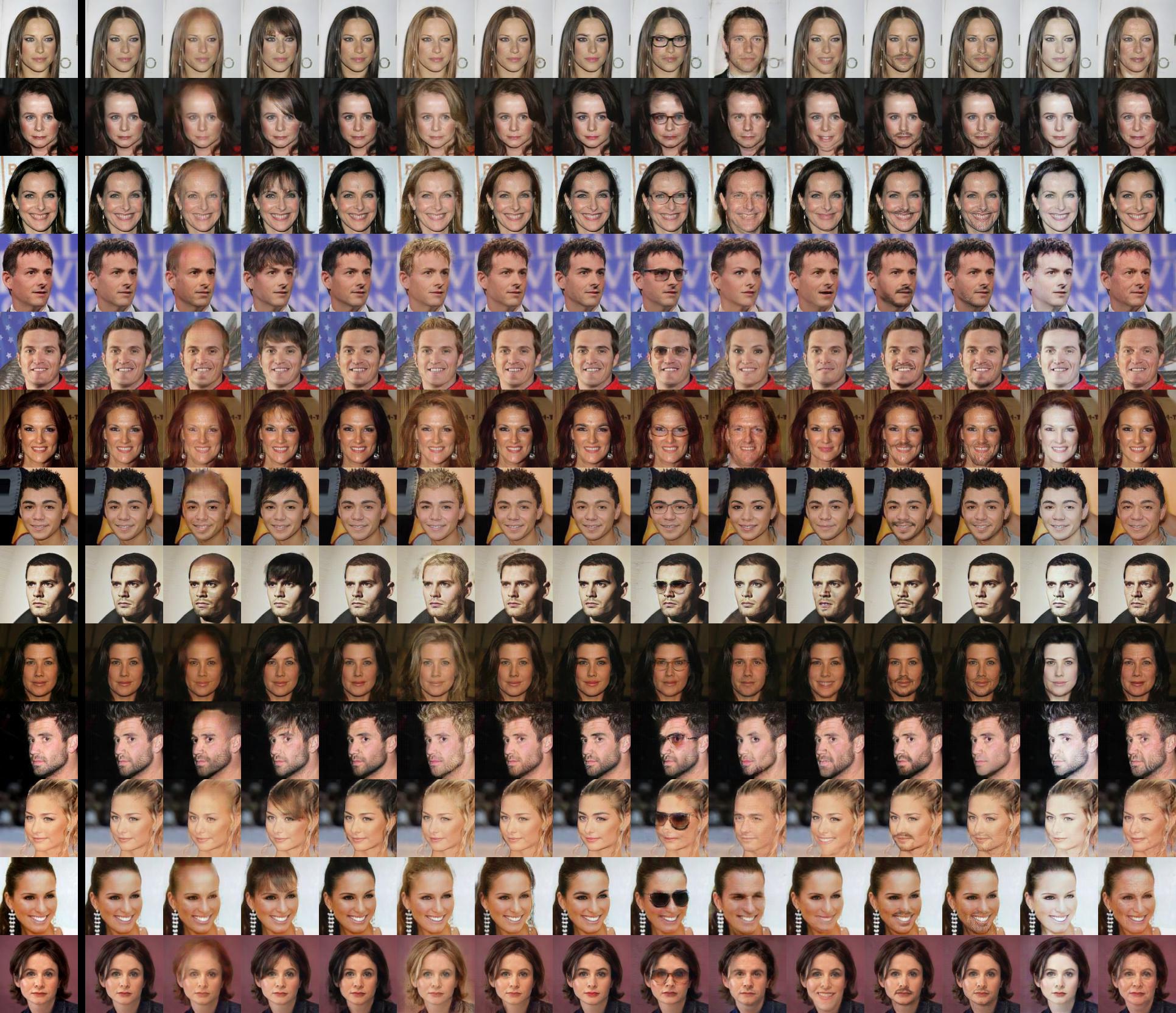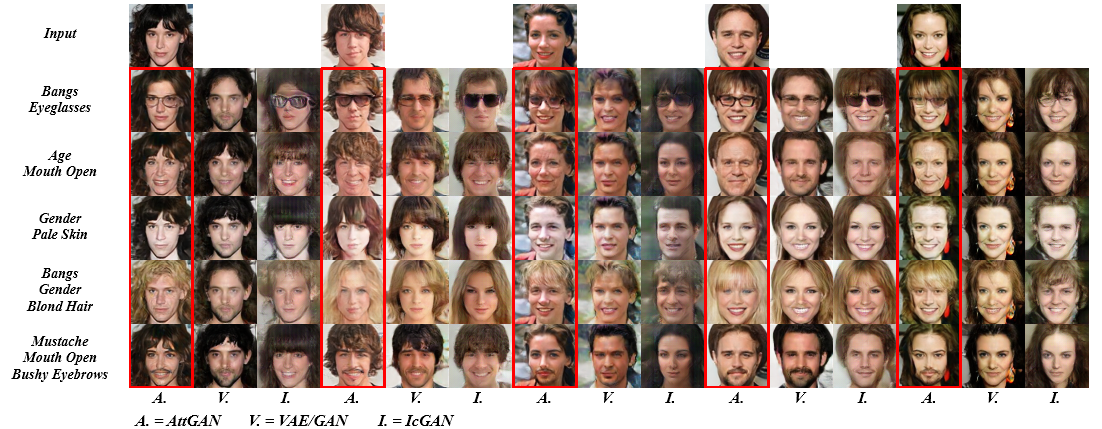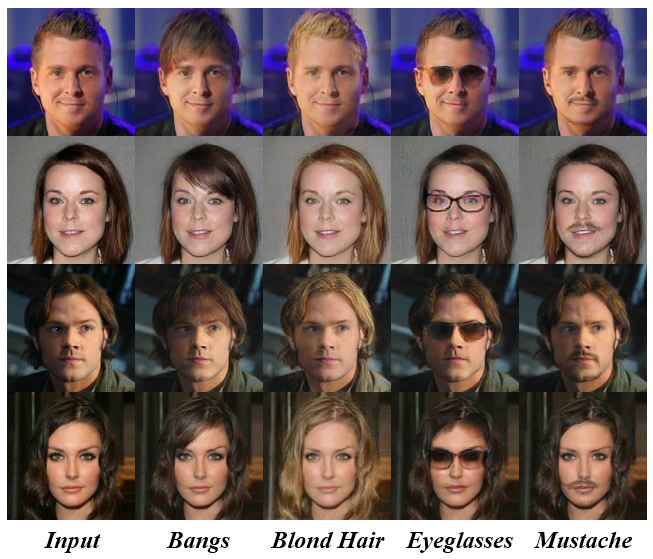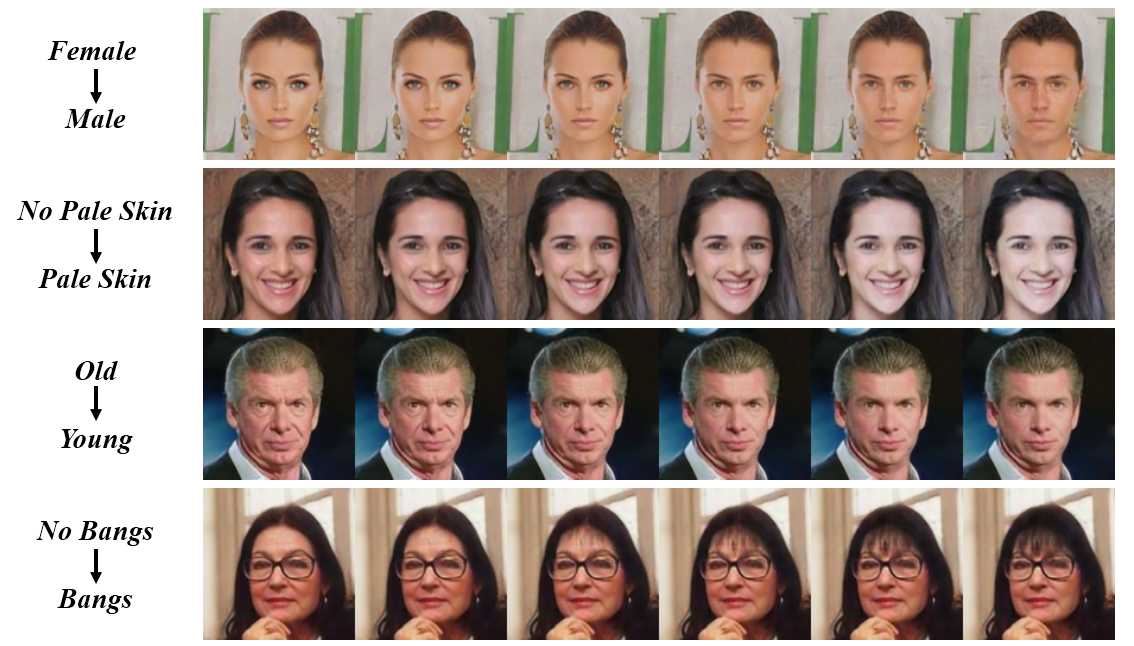Tensorflow implementation of AttGAN - AttGAN: Facial Attribute Editing by Only Changing What You Want
-
Other AttGAN implementations
- AttGAN-PyTorch by Yu-Jing Lin
-
Closely related works
- An excellent work built upon our code - STGAN (CVPR 2019) by Ming Liu
- Changing-the-Memorability (CVPR 2019 MBCCV Workshop) by acecreamu
- Fashion-AttGAN (CVPR 2019 FSS-USAD Workshop) by Qing Ping
-
An unofficial demo video of AttGAN by 王一凡
-
See results.md for more results, we try higher resolution and more attributes (all 40 attributes!!!) here
-
Inverting 13 attributes respectively
from left to right: Input, Reconstruction, Bald, Bangs, Black_Hair, Blond_Hair, Brown_Hair, Bushy_Eyebrows, Eyeglasses, Male, Mouth_Slightly_Open, Mustache, No_Beard, Pale_Skin, Young

-
Comparisons with VAE/GAN and IcGAN on inverting single attribute

-
Comparisons with VAE/GAN and IcGAN on simultaneously inverting multiple attributes

-
Prerequisites
- Tensorflow 1.7 or 1.8
- Python 2.7 or 3.6
-
Dataset
-
Celeba dataset
- Images should be placed in ./data/img_align_celeba/*.jpg
- Attribute labels should be placed in ./data/list_attr_celeba.txt
- the above links might be inaccessible, the alternatives are
- img_align_celeba.zip
- list_attr_celeba.txt
-
HD-Celeba (optional)
- the images of img_align_celeba.zip are low resolution and uncropped, higher resolution and cropped images are available here
- the high quality data should be placed in ./data/img_crop_celeba/*.jpg
-
-
Well-trained models: download the models you need and unzip the files to ./output/ as below,
output ├── 128_shortcut1_inject1_none └── 384_shortcut1_inject1_none_hd -
Examples of training
-
see examples.md for more examples
-
training
-
for 128x128 images
CUDA_VISIBLE_DEVICES=0 \ python train.py \ --img_size 128 \ --shortcut_layers 1 \ --inject_layers 1 \ --experiment_name 128_shortcut1_inject1_none
-
for 384x384 images
CUDA_VISIBLE_DEVICES=0 \ python train.py \ --img_size 384 \ --enc_dim 48 \ --dec_dim 48 \ --dis_dim 48 \ --dis_fc_dim 512 \ --shortcut_layers 1 \ --inject_layers 1 \ --n_sample 24 \ --experiment_name 384_shortcut1_inject1_none
-
for 384x384 HD images (need HD-Celeba)
CUDA_VISIBLE_DEVICES=0 \ python train.py \ --img_size 384 \ --enc_dim 48 \ --dec_dim 48 \ --dis_dim 48 \ --dis_fc_dim 512 \ --shortcut_layers 1 \ --inject_layers 1 \ --n_sample 24 \ --use_cropped_img \ --experiment_name 384_shortcut1_inject1_none_hd
-
-
tensorboard for loss visualization
CUDA_VISIBLE_DEVICES='' \ tensorboard \ --logdir ./output/128_shortcut1_inject1_none/summaries \ --port 6006
-
-
Example of testing single attribute
CUDA_VISIBLE_DEVICES=0 \ python test.py \ --experiment_name 128_shortcut1_inject1_none \ --test_int 1.0
-
Example of testing multiple attributes
CUDA_VISIBLE_DEVICES=0 \ python test_multi.py \ --experiment_name 128_shortcut1_inject1_none \ --test_atts Pale_Skin Male \ --test_ints 0.5 0.5
-
Example of attribute intensity control
CUDA_VISIBLE_DEVICES=0 \ python test_slide.py \ --experiment_name 128_shortcut1_inject1_none \ --test_att Male \ --test_int_min -1.0 \ --test_int_max 1.0 \ --n_slide 10
If you find AttGAN useful in your research work, please consider citing:
@article{he2017attgan,
title={Attgan: Facial Attribute Editing by Only Changing What You Want},
author={He, Zhenliang and Zuo, Wangmeng and Kan, Meina and Shan, Shiguang and Chen, Xilin},
journal={arXiv preprint arXiv:1711.10678},
year={2017}
}


